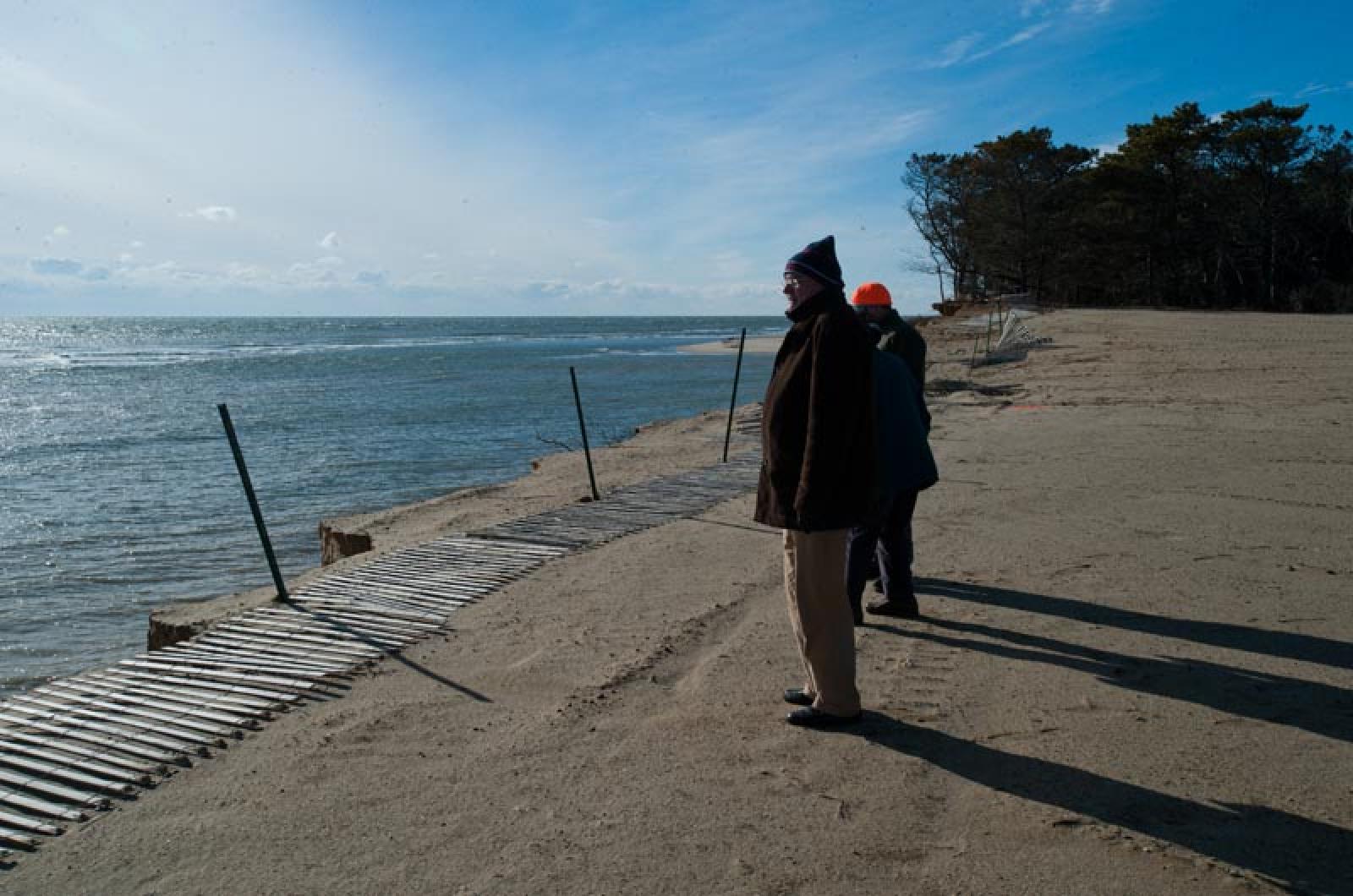Chappaquiddick erosion issues dominated the agenda of the Edgartown conservation commission this week, from the extensive landscape restoration project at the Schifter property to the fate of the house owned by Jerry and Sue Wacks that must be at least partially torn down before it falls into the sea.
At a site visit Monday the commission viewed both properties which lie at the Atlantic-facing edge of Chappy where significant erosion has returned as the Norton Point breach recedes.
The Wacks home now sits just 20 feet from the edge of Katama Bay, with erosion occurring at the rate of about a foot a day. On Wednesday the commission agreed to send a letter clearing the way for emergency demolition of most of the house.
“To prevent the house from ending up in Katama Bay, out into Nantucket Sound or washing up on adjacent beaches,” the commission wrote in part. The letter went out yesterday. It is understood that the Wackses plan to demolish all but two bedrooms and a utility room in the modest house, built 30 years ago in a spot that at the time was on high ground overlooking the bay.
Also on Wednesday the board reviewed a landscaping and erosion control plan for the Wasque home owned by Richard and Jennifer Schifter. The plan calls for restoring trees, shrubbery and sandplain grasses that were stripped from the land when the 8,000-square-foot house was relocated over the summer. The plan also includes installing a new system of straw logs, called wattle logs, and hydromulching to strengthen the embankment where the house now sits.
Trees, shrubbery and topsoil that were removed last summer in preparation for the house move are still stored offsite on property owned by Gerald Jeffers. The commission said this week it’s time to restore the property to its previous state.
“Yes, we okayed the pile of sand [that was used to stave off more erosion while the house was being moved] but why can’t we just go back to the contour and trees and bushes that were there before the pile of sand,” commission member Christina Brown said. “Those contours had a thick understory and some significant bushes and trees. Why can’t they have it again?”
But commission member Bob Avakian said the site visit was eye-opening for him. “I think we learned a hard lesson,” he said. “We should have had this discussion before you can say, okay you can cut down trees.”
The commission decided to require 35 trees to be planted along the front of the bluff, 10 more than the 25 first proposed.
The plan now calls for applying about two acres of hydromulch over the outer perimeters of the eight-acre property. The hydromulch is intended to strengthen the embankment. Six straw wattle logs, encased in a fiber netting, will be dug into a shallow trench along the embankment for erosion control.
That will be done over the winter, with landscaping scheduled for the spring. A groundcover of bearberry, sweet fern, and little bluestem is planned.
Red cedars and pitch pines will be planted along the front of the embankment. About 130 trees will be planted in total across the property, as well as 1,170 shrubs, according to the plan. A monitoring system still in development will gauge the success of the erosion control measures. A final order of conditions will be considered by the conservation commission in January.
Landscope vice president Josh Kochin, who works for the Schifters and attended the meeting, said the plan calls for creating a test area where the hydromulch will be rototilled into the soil in order to study the impact on drainage and infiltration rates.
“I think we’re going to find out a lot about that depending on the speed of the rototiller and how many passes through we do, things like that,” Mr. Kochin said.
The landscape architect for the project is Kris Horiuchi of Horiuchi Solien Landscape, who also attended the meeting.
She said there is no guarantee that the native vegetation will survive when it is replanted.
“We’re starting at a point now where it’s exposed as opposed to having plants growing up together,” she said. “The challenge is for these plants to survive because they’re totally exposed . . . they all grew up together as a unit of vegetation. It’s a different situation where we’re putting new plants out there in a totally exposed environment.”
Commission member Lil Province, who is also a landscape architect, agreed.
“The more exposure, the less success,” she said. “You’re dealing with mother nature out there. You can’t put a windscreen up to protect those plants. The best they can do is plant the plants and baby them as much as they can.”
But Mrs. Brown pressed the point of full restoration.
“Restoration to me is restoring what is there and what was there was more vegetation,” she said. “Of course we don’t have a comparison because we’ve never had a house move before.”






Comments (3)
Comments
Comment policy »